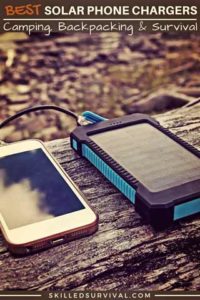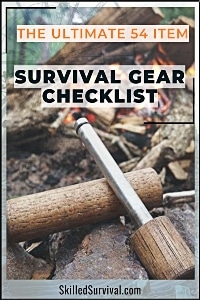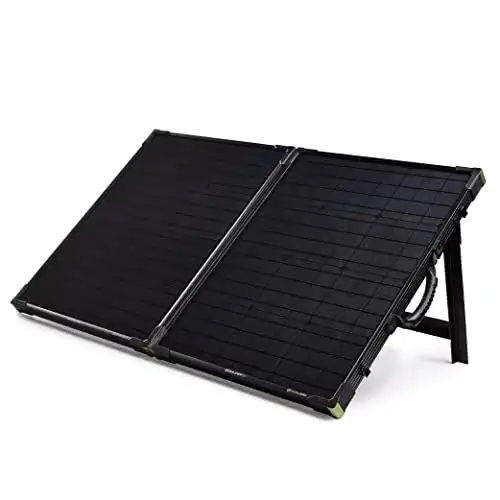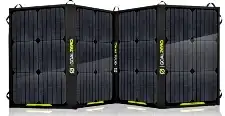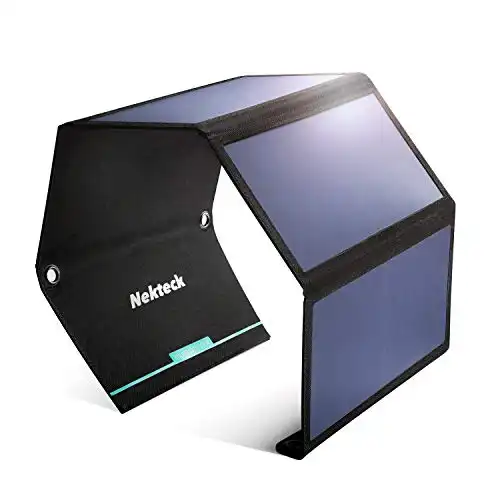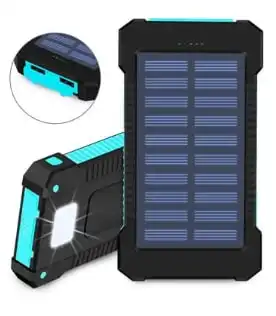Today I’ve got something important to share…
A Review Of The Best Solar Phone Chargers For Your Money
Because I’ll bet you a ham sandwich, you’re reading this on your phone.
OR you have a phone within arm’s reach.
Now, I may be wrong once and a while.
But I’m pretty sure I won’t be going hungry anytime soon.
Why? Because in 2021, 85% of the US population owned a cell phone.
The day is coming fast when everyone owns a solar phone charger to keep their phones topped off.
Because there’s nothing more annoying and frustrating than running out of power midday!
This quickly makes the portable solar-powered phone charger the new “must-own” tech device.
TOPICS IN THIS GUIDE… ↓(click to jump)
- Why Invest In A Solar Phone Charger
- 3 Types Of Solar Phone Chargers
- Direct Chargers
- Indirect Chargers
- Phone Case Chargers
Want a free 54 item survival gear checklist?
Click here to instantly download this Complete Checklist PDF. No purchase necessary.
Why You Should Invest In A Solar Phone Charger
The Perfect Plan B
As I pointed out already, nearly everyone owns a cell phone or smartphone.
Everyone (from teenagers to grandparents) is getting in on the act.
And as we know, smartphones are so much more than “traditional phones.”
They are a:
- Camera
- GPS device
- Internet browser
- Video game console
- Recording device
- Music player
- Etc.
But these technical devices require copious amounts of power to operate – all while on the go.
So they’re designed with a rechargeable battery.
But those batteries run out way too fast – often at inconvenient times and locations.
You know, those remote places without access to electrical outlets.
In the past, you just had to accept that and deal with the consequences.
For example:
- Maybe you lost your GPS mid-travel and had no map. Oops.
- Or perhaps you wanted to capture a special moment only to find your phone dead – missing out on the perfect picture.
- Or worse yet, what about if you got lost in the wilderness with no way to call for help...
But with a solar charger, you can get that phone back up and running – ANYWHERE.
So a solar phone charger act as a power backup for normal times and a lifesaver device in times of dire emergency.
Save Some Money
If you use your solar phone charger often, it will save you some money over an extended period of time.
Now, it depends on how much you spend upfront on the solar charger.
Using the sun’s “free” energy is great, but it’s not “savings” if the cost of the device is prohibitive.
But, as solar phone charger prices fall and your electric rates rise, you can save real money.
We’re not quite there yet to fully offset the device’s original cost (at least not quickly).
However, a solar charger can still help offset much of your initial investment.
For example, let’s say it costs you $25 for the charger, and you use it often (daily).
Let’s say you saved $1 in electricity each month by using a solar phone charger often instead of plugging it into your home’s outlet.
That math would add up to $12 per year.
No, $12 won’t make you rich. But the device you buy today slowly pays for itself little by little over time.
This is what I like to call a B.T.N. investment = Better Than Nothing
Environmentally Friendly
If you’re someone who wants to reduce your carbon footprint, then this is a no-brainer.
Harnessing the sun’s power to keep your phone charged helps offset your carbon footprint.
Now, there is a carbon cost to manufacture the device in the first place – so it might not be 100% “carbon” friendly.
However, it’s better at offsetting carbon than all the other survival gadgets you buy yearly.
↓ Do Portable Solar Power Chargers Really Work?
Want a free 54 item survival gear checklist?
Click here to instantly download this Complete Checklist PDF. No purchase necessary.
3 Types Of Solar Phone Chargers On The Market
There are hundreds of solar charging solutions on the market today.
They are designed to keep your phone powered – whether at the beach, while camping, or in an emergency.
And while each design has its own small twist. Solar-powered phone chargers tend to fall into one of three categories.
- Direct (no battery bank)
- Indirect (has a battery bank)
- Case Chargers (no battery bank)
Choosing the right one depends on how you plan to use it – and how you use your phone.
A direct charger makes things simple and efficient.
They are the best solution if you plan to be in one place during the day and aren’t on your phone all the time.
A battery bank charger is best if you need to be on the go.
For example, if you can’t stop to charge your phone until you’re back home.
And if you can’t be bothered with packing extra gear, you might want a case charger.
It automatically extends your phone’s battery life when you’re not using it.
↓ Solar Power Banks Vs. 28 Watt Solar Power Chargers
But that’s just a quick rundown.
Let’s now deep dive into each solution a bit more.
That way, you can zero in on the solution that will work best for you.
Direct Chargers
Direct solar phone chargers are often called solar panel phone chargers.
They connect straight from a solar panel directly to your phone via a USB cable.
The USB connection offers a simple way to connect your phone to the panel with the charging cable.
A solar panel phone charger is also the most efficient form of solar charging.
That’s because you lose some efficiency whenever electricity is transferred between components.
Each transfer step has a small efficiency cost due to resistance.
These transfers add up and erode the total charge available to your phone.
So, if you choose a direct panel solution, you remove these transfer losses.
Helping you maximize the amount of charge reaching your phone.
Direct panel chargers also include only a few internal parts and minimal, delicate circuitry.
Helping to make them far more robust and weather-resistant compared to other options.
This comes in handy when you can’t always count on the weather to be clear.
Of course, direct charging from a solar panel also has a few drawbacks.
First, solar panels have difficulty producing a consistent flow of electricity.
Variables (such as clouds, shadows, etc.) create stronger and weaker signals over time.
This translates to slower charging and longer wait times as your devices charge.
During this time, your phone must stay connected to the solar charger for longer to reach a full charge.
So if you have a large solar panel, you’re basically tethered to one location.
This makes it harder and less convenient to use.
For example, a single full charge could take up to 5 hours of full sun.
This means re-aiming the panel often to collect the most energetic rays throughout the day.
Second, the power output of a solar panel is directly related to the amount of incoming sunlight.
This means that the voltage levels will fluctuate throughout the day – and even in passing clouds.
Clearly, this means more power in full, bright sunlight, and your phone will charge faster.
But, in low light conditions, your charger may not charge enough to register on your phone.
Modern phones may stop charging if it senses electrical variations in the voltage.
They do this to protect the phone when power surges at home.
But it can also prevent you from charging via solar panels if the output is too unpredictable.
Have you ever seen the “This device is not supported” message when using a cheap charger?
This is because the cheap chargers are too variable, and some phones don’t like them.
Finally, the old criticism of “what about when it’s dark out?” applies here.
With a direct charger, you can only charge during daylight hours.
If you’re on the move or have bad weather during the day, this can damage your charging capabilities.
↓ Solar Panel Comparison: What To Consider Before Buying
Direct Solar Phone Charger Examples
Goal Zero Boulder 100 Briefcase, 100 Watt Monocrystalline Solar Panel
This is a briefcase-sized solar panel charger and is perfect for remote campsites.
This unit is too large to carry around daily but will charge your phone quickly.
Plus, it can charge so much more than just your mobile phone.
It can charge a battery bank to keep ALL your battery-powered devices going.
↓ Goal Zero Boulder 100 Watt Briefcase Solar Panel Review and Unboxing
Goal Zero Nomad Series
This portable solar panel series is made for easier transportation – hence the name “Nomad.”
All these options allow you to directly charge your phone, harnessing the sun’s power while on the go.
Portable, rugged, and powerful, it can be chained with other solar panels to collect more power from the sun.
↓ GoalZero Nomad Portable Solar Panel Review
Nekteck 28W Solar Charger, Portable Solar Panel
This solar panel phone charger is a well-designed unit.
It includes fast charging technology, so you spend less time waiting for your phone to charge.
But you can take it anywhere due to its lightweight construction (18 oz).
It also includes dual USB ports so you can charge multiple devices simultaneously.
↓ Unboxing NekTeck 28W Solar Charger
Solar Battery Banks
If the headaches of direct charging are too much to deal with, a solar charger with a battery bank solar charger may be the better bet.
Adding a high-capacity external battery solves several flaws of direct charging solar systems.
Battery banks are commonplace these days, with capacities of up to 20,000mAh.
This is more than enough to charge your phone several times over.
This can really be a lifesaver when you only have opportunities to collect a solar charge every few days.
They also allow you to leave home at full charge.
In addition to high-capacity batteries, they also have high-quality charging circuits.
Circuitry that’s far less sensitive to voltage fluctuations.
This means they will charge far better in partly cloudy conditions and at low light.
Allowing you to collect more power than a direct system.
Maybe most importantly, battery banks mean you can charge where and when it’s convenient.
You can charge the battery bank all day while going about your business.
Then later, use it to charge your phone overnight (or whenever is most convenient).
Meaning you can wake up to a full phone battery and get more done throughout the day.
On the other hand, a battery bank DOES mean one more device added between the sun and your phone.
As we mentioned earlier, this also means suffering a bit more transfer loss along the way.
A quality battery bank will minimize that loss and more than makeup for it in available power.
↓ EVERY SOLAR PANEL Type Compared – Mini Solar Panel Reviews
Solar Battery Bank Examples
EVATAC – Anytime Portable Solar Charger
Skilled Survival highly recommends the Anytime Charge Solar Power Bank.
Why? Because it’s one of the most durable, compact, and cost-effective portable solar chargers on the market today.
But don’t let its compact size fool you; it’s also got a massive 10,000 mAh battery capacity!
The massive battery storage is enough to charge any device multiple times. Plus, with dual charging outputs, you can power multiple devices simultaneously!
Simply plug in your devices via the supplied USB cable (you can use any USB cable) and press the power button.
Your device will begin to take power from the Anytime Charge right away.
Recharging the Anytime Solar Bank couldn’t be easier – leave it in the sun, and it will automatically fill the large battery bank back up ANYWHERE.
Plus, it’s splash resistant and comes with an emergency flashlight with a strobe function.
Want a free 54 item survival gear checklist?
Click here to instantly download this Complete Checklist PDF. No purchase necessary.
Final Thoughts
If you’ve made it this far into the article, you are apparently very interested in this new technology.
I carry a solar phone charger with me every single day.
I take it camping, I take it to work, and I use it at home.
It’s one of those devices you’ll probably use every day.
And it may just save your butt every once in a while.
It’s one of my favorite pieces of survival gear.
It’s one of the better purchases I’ve made recently, with no regrets!
And if you want to take solar technology to an even larger scale – check out our article on the best solar generators.
Why Trust Skilled Survival…
Go here now to review a full breakdown of:
- Who We Are
- Our Credentials
- Our Mission
- & Product Recommendations…
Here are a few highlights of our teams credentials & certifications:
- Certified Member of a Mountain Search & Rescue Organization
- Plant Emergency & Safety Leader for a Major Food Manufacturer
- Member of the 10TH Mountain Division Hut Association
- Certifications: Avalanche 1, WFR, CPR
- Official Gear Tester for Numerous Outdoor Gear Companies
- Countless Multiday Backpacking trips into Remote Wilderness
- Bachelor’s Degree In Mechanical Engineering
- Bachelor’s Degree In Civil Engineering
- Bachelor’s Degree In Biomedical Engineering
“It takes 20 years to build a reputation and five minutes to ruin it.” – Warren Buffett
We’re fully aware that TRUST is NOT something you GET but is EARNED.
And we’ll continue to earn YOUR trust through our forthright and honest approach with each new Blog Post, Guide & Product we create…
Jason K.
P.s. Do You Live In A ‘Danger Zone’ County?
Find out now using my Danger Zone County List & Special Report it’s absolutely FREE.
In minutes you’ll know EXACTLY where you stand and if you should be worried or not..
So click here to get my FREE Danger Zone County List & Report…
The post Best Solar Phone Chargers: Is This New Tech Worth Owning? appeared first on Skilled Survival.



